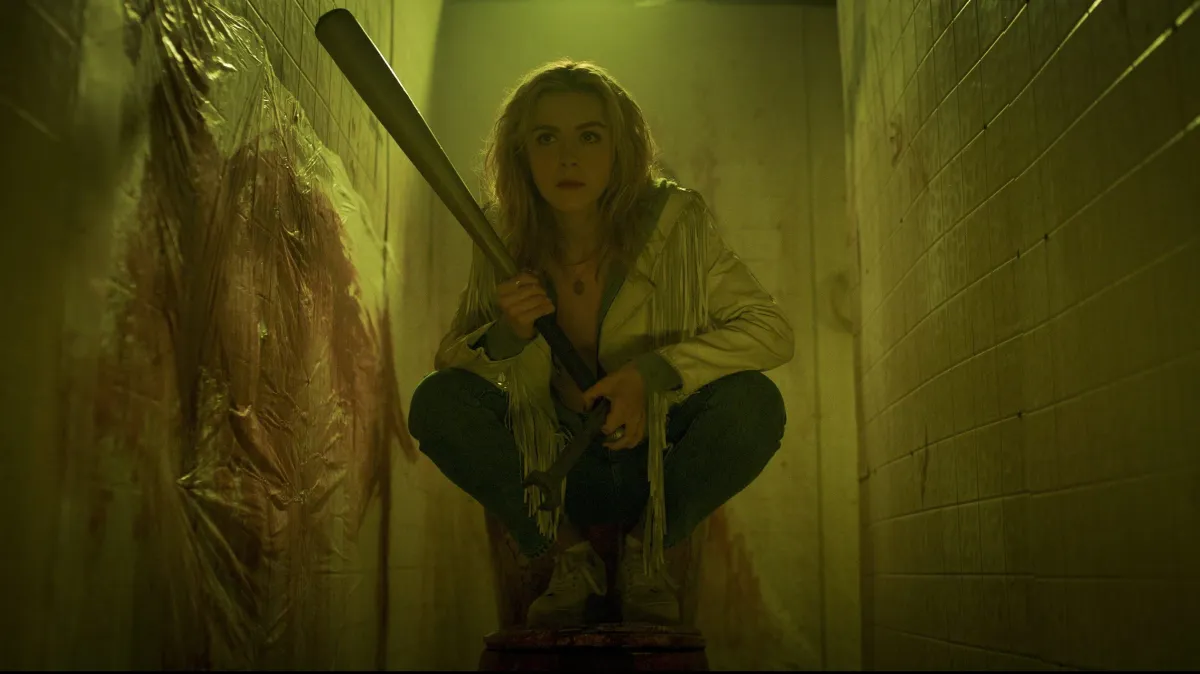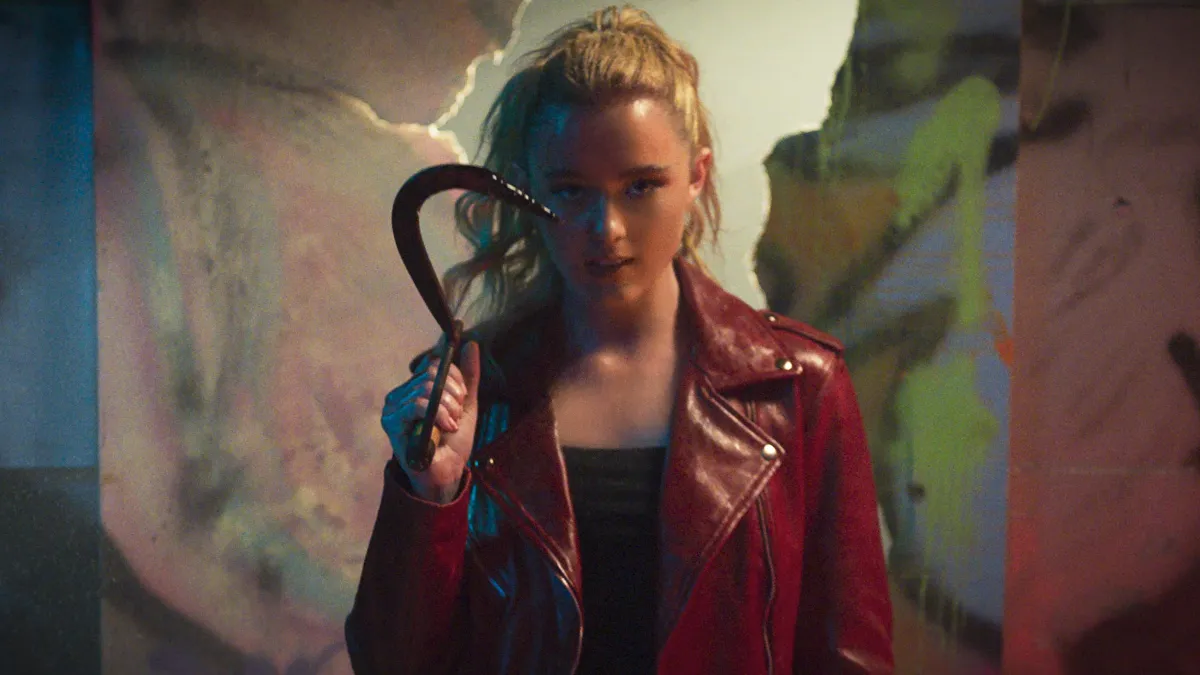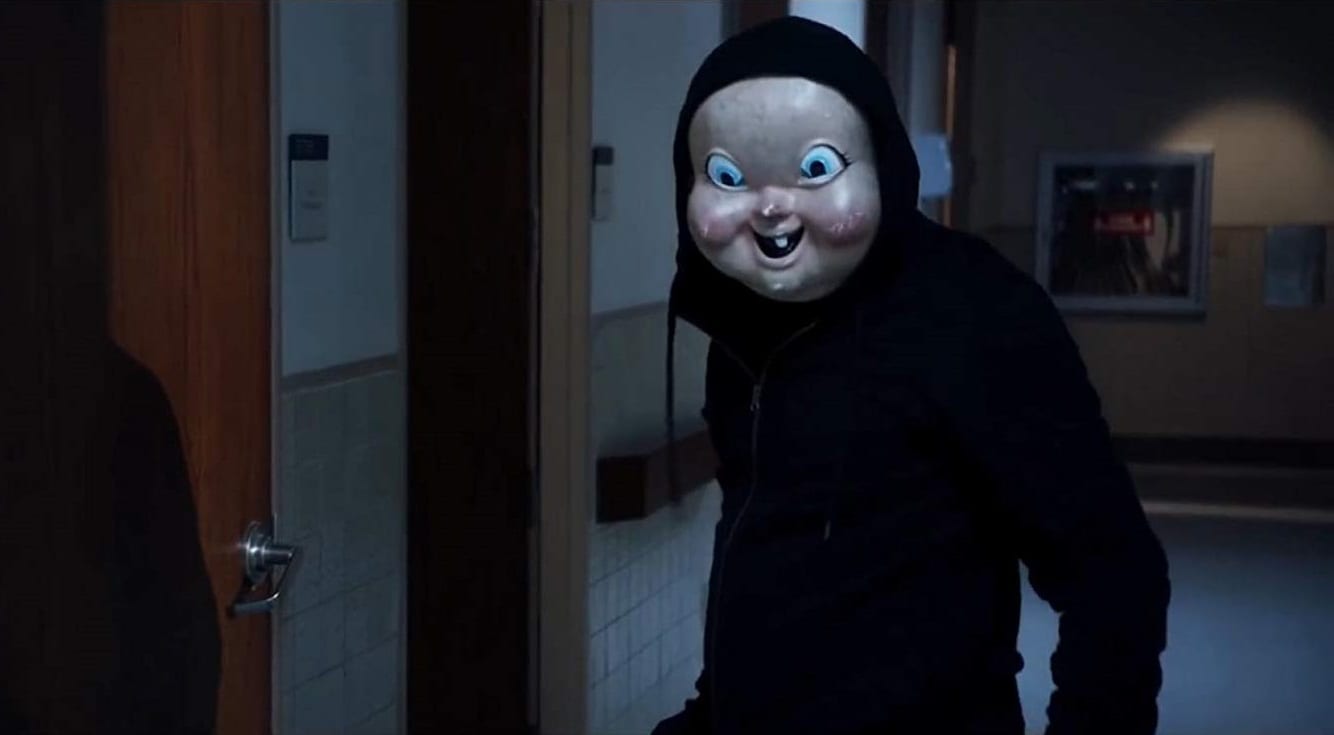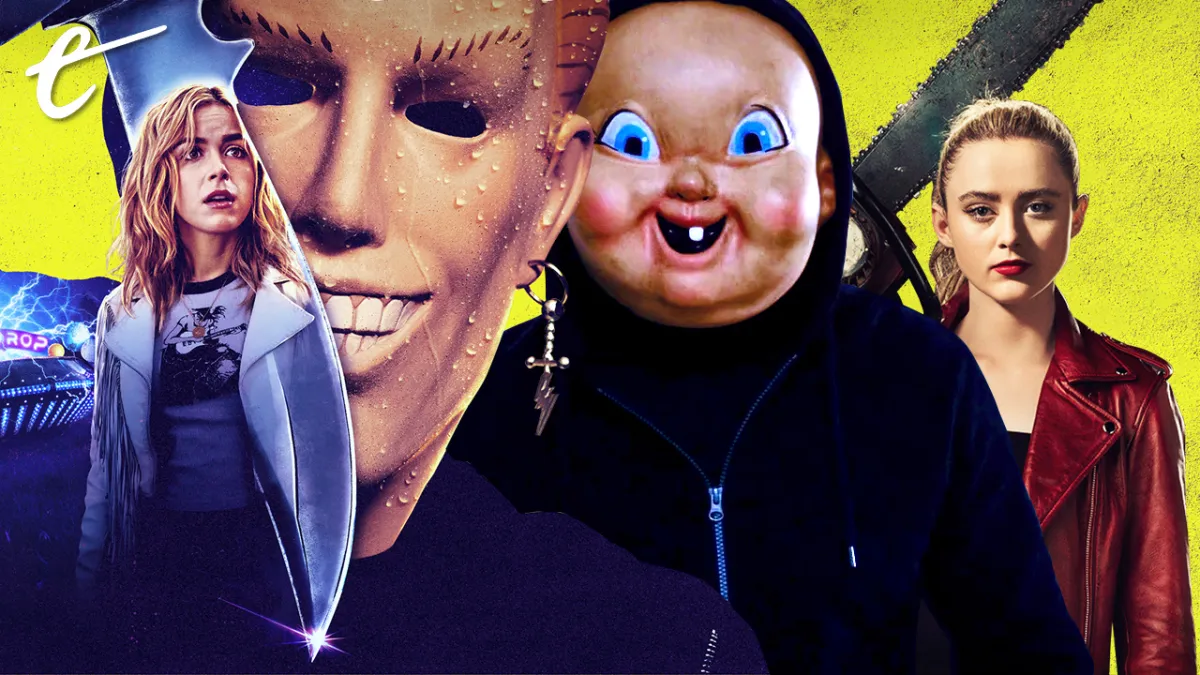There are few Hollywood genres quite as malleable as the slasher movie.
This is typified by the new wave of hyper-self-aware entries in the horror subgenre. Totally Killer, which released on Prime Video this month, sends Jamie Hughes (Kiernan Shipka) back to the 1980s in a riff on Back to the Future. It’s a Wonderful Knife, which will release theatrically mid-November and on Shudder for Christmas, finds Winnie Carruthers (Jane Widdop) thrown into an alternate universe where she never existed in an obvious allusion to the basic premise of It’s a Wonderful Life.
Totally Killer and It’s a Wonderful Knife epitomize a wave of modern slasher movies, which include theatrical releases like Happy Death Day or Freaky. These films often involve throwing self-aware characters into narratives that hybridize the classic slasher template with a high concept from another beloved 1980s classic. Happy Death Day plays on the basic concept of Groundhog Day, while Freaky evokes the body swap comedy of Freaky Friday — it was originally titled Freaky Friday the 13th.
Taken together, these movies could be seen to represent something of a third wave of the classic slasher movie. These films demonstrate both the sturdiness of the classic slasher formula and the versatility of the template. They are proof that the slasher movie has been consistently and rapidly evolving, finding new and interesting ways to remain relevant even as audiences grow increasingly familiar with the genre’s tropes and conventions.
The slasher subgenre has a long and contested history, possibly stretching back beyond Black Christmas, Peeping Tom, and Psycho, but it was largely codified with the release of John Carpenter’s Halloween in 1978. Halloween was such a massive success that it inspired a wave of imitators into the early and mid ‘80s. These movies could be produced quickly and cheaply, so it was possible to flood the market with cheap and disposable schlock.
Depending on how loosely one defines the terms “slasher,” that boom could encompass classics like Ridley Scott’s Alien or Stanley Kubrick’s The Shining. It attracted filmmakers like legendary director John Huston (Phobia), New Hollywood icon William Friedkin (Cruising), and Godfather cinematographer Gordon Willis (Windows). However, a lot of the entries in the genre tended to be disposable and forgettable. As a result, the trend burnt itself out fairly quickly.
During the early 1980s, there were so many slashers being released that they often tripped over each others’ release dates. The Burning and Graduation Day both released on May 8th, 1981. Just a week later, The Fan and Happy Birthday to Me also hit cinemas simultaneously. Film historians talk about the oversaturation of musicals and westerns, but the glut of slasher movies in the years following Halloween quickly rode the genre into the ground.

The major slasher franchises like Halloween, Friday the 13th, and A Nightmare on Elm Street, later joined by the Child’s Play series, would limp into the 1990s. However, there was a sense of fatigue. This was not a sustainable long-term model. It likely didn’t help that the ubiquity of the slasher made it fodder for both academic interrogation like Carol J. Clover’s Men, Women, and Chainsaws and more populist critical dissection by shows like Gene Siskel and Roger Ebert’s Sneak Previews.
However, the speed with which these movies could be produced and the volume of discourse around them lent the slasher genre a certain self-reflexive quality. Audiences didn’t just watch the movies, they also understood them. Long before the internet popularized discussions of “Campbellian archetypes” or “Save the Cat plotting,” audiences could instinctively grasp the internal logic of these very simple and straightforward horror movies. They could engage with them as a set of clichés.
This level of detachment might have been necessitated by the films’ content. Slasher movies were hugely controversial for their depiction of highly sexualized violence against women, often coded in an extremely reactionary manner. Critics like Ebert lamented that these movies asked the audience to identify “not with the victim but with the attacker, the killer.” As such, an ability to maintain a distance from the genre – to keep it at arm’s length – makes it less unsettling and easier to enjoy.
As a result, the genre was ripe for reinvention. Wes Craven and Kevin Williamson’s Scream did the trick, released in December 1996. It’s hard to overstate Scream’s impact. As George A. Romero put it, “The genre was dying and Scream saved it.” Building off Craven’s experimentation in Wes Craven’s New Nightmare, Scream was self-aware. It was a slasher movie in which the characters knew the rules of the slasher movie. They understood the genre just as well as the audience did.
This ushered in the era of the postmodern slasher movie, the second wave of the classic slasher movie. The structure of these films was basically identical to that of the classic stalk-and-slash horror film, but there was always a knowing wink to the viewer. The victims had watched many of the same classic horror films as anybody sitting in the cinema. In Scream, video store nerd Randy (Jamie Kennedy) pauses Halloween to articulate the guiding principles for a party full of teenagers.
Scream refreshed the genre. Teenagers could watch these slasher movies knowing that they were slasher movies, and so existing at an emotional and psychological distance from the source material. These films could rely on the same clichés and formulas, but could also engage critically and cleverly with them, drawing attention to the conventions and the logic of these movies. Scream 2 opens with Maureen (Jada Pinkett) and Phil (Omar Epps) discussing the racial politics of the slasher genre.

Once again, there was a rush to cash in on this success. These movies could be turned around quite quickly, so studios flooded the market with similarly self-aware slashers like I Know What You Did Last Summer, Urban Legend, The Faculty, and Cherry Falls. Scream 2 hit cinemas just a year after the original. Even long-running slasher franchises got in on the act. Kevin Williamson contributed to Halloween H20. These films were an obvious influence on Bride of Chucky.
As with the earlier cycle, this spate of postmodern slashers burnt itself out quite quickly. Self-awareness gave way to self-parody. Scream was supplanted by Scary Movie. Halloween H20 was followed by Halloween: Resurrection, in which Busta Rhymes delivers the one-liner “trick or treat, motherfucker” and roundhouse kicks Michael Myers (Brad Loree). Even the broadly comedic Bride of Chucky gave way to the campy insanity of Seed of Chucky.
In some ways, the grim-and-gritty and torture-porn-inflected spate of horror remakes that began with Marcus Nispel’s 2003 version of The Texas Chainsaw Massacre could be seen as a reaction against and rejection of this spate of self-aware slashers. These movies offered a more grounded and back-to-basics approach to the genre, delivering their kills in a much more straightforward manner. That said, these tended to be remakes of existing properties, rather than fresh stabs at the slasher template.
These days, the existing slasher franchises like Halloween, Candyman, Scream and Texas Chainsaw Massacre tend to be tied up in nostalgic “requels.” These are films revisiting old characters and actors, repackaging familiar premises in a fairly straightforward but accessible manner for mass audiences. That said, these films are perhaps best understood as franchise installments and brand extensions rather than as works indicative of the larger slasher genre.
It’s worth considering some of the breakout “original” slasher movies to emerge over the past few years. Just as Scream added a level of self-aware abstraction to the template established by Halloween, these films add an extra self-referential layer on top of that. Released in 2015, The Final Girls is a great example. The characters don’t just reenact slasher movie clichés. They are literally trapped inside a slasher movie, escaping into the cinema screen as the theater burns around them.
While movies like It’s a Wonderful Knife, Totally Killer, Freaky, and Happy Death Day are very explicit in their pop horror sensibility, the trend arguably carries over into more indie horror. Films like Ti West’s X trilogy or Prano Bailey-Bond’s Censor are horror movies very much engaged with cinema. In X, West blends The Texas Chain Saw Massacre with Debbie Does Dallas. In Pearl, he quotes extensively from The Wizard of Oz. These are horror films that ask to be understood as horror films.

This approach cleverly sidesteps a lot of those early criticisms of the gender politics and worldview of the slasher. As if responding to Ebert’s criticism of the genre, these films don’t ask the audience to identify with the killer or the violence on screen. Instead, they ask viewers to engage with the genre as a collection of ideas, imagery, and iconography that can be applied, interrogated, or subverted. The slasher movie is a set of concepts and conditions. It is not framed as a representation of reality.
Scream made this point by having its characters openly discuss and debate the logic underpinning the slasher movie. Movies like Happy Death Day and Totally Killer take it further, by emphasizing that the tropes of a slasher movie can be thrown into a blender with any other high concept. These are films that demand to be understood as films, as genre exercises. It’s an approach that has arguably kept the slasher more vibrant than other dormant genres like westerns or musicals.
As much as slashers have traditionally been seen as cheap and disposable, these movies assume a degree of media literacy from viewers. It likely helps that, on top of being produced quickly and cheaply in a way that can encourage experimentation impossible on bigger budget films, horror movies tend to be aimed at younger audiences. These movies are often pitched at an audience that has been exposed to self-aware media from a young age, and so understands these stories as stories.
In Happy Death Day, Tree (Jessica Rothe) and Carter (Israel Broussard) discuss how closely the movie is hewing to Groundhog Day. In Totally Killer, Jamie frequently evokes Back to the Future in trying to understand and explain her situation, while Sheriff Lim (Randall Park) wryly complains that time-travel movies never make sense. These are movies about movies. They are not necessarily wired into the same set of political or social anxieties that informed the original wave of slashers like Halloween.
All movies are staged and constructed, but these films draw attention to their unreality. This is a clever approach. It allows the slasher to have its cake and eat it. By framing these examples as films knowingly applying a classic genre template, the slasher movie can avoid a lot of potential arguments about its place in a post-#MeToo landscape. It allows the audience to enjoy the pleasures of the slasher – the suspense, the catharsis, the spectacle – at a remove from potentially unsavory context.The theatrical poster for the 1972 horror film Last House on the Left warns the reader, “To avoid fainting, keep repeating it’s only a movie.” These days, audiences don’t need to remind themselves. The movie will do it for them.






Published: Oct 24, 2023 11:00 am